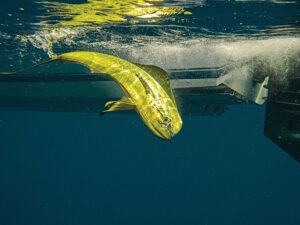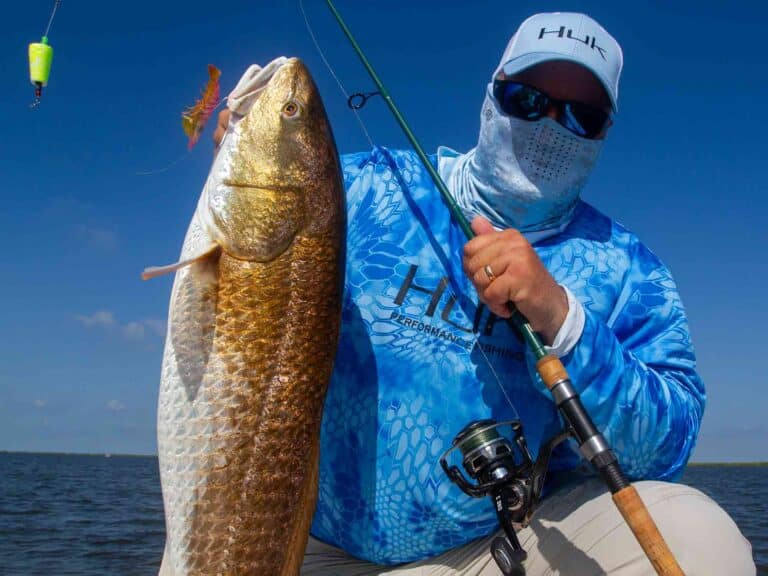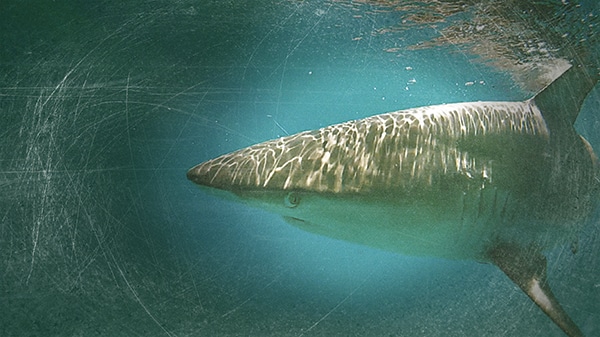
Ever grab a stray cat? Then you have an idea what it’s like to hook a spinner shark. The battle will likely be over before you have time to read the next paragraph. At least that’s how it was before South Florida anglers figured out how to beat the odds that favored these sharks and their airborne antics.
Shark skin is covered with tiny denticles, or toothlike scales. Combine that with the aerial gyrations spinners are known for, and you’ll see why fishing lines are pushed to their limit. And like that feral cat, they keep squirming as they vault their way to freedom.
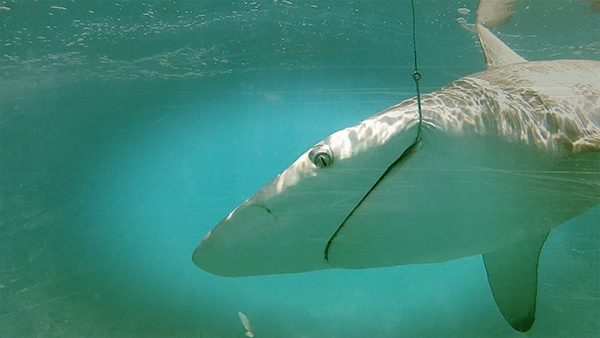
Tough Package
Spinners are built like high school halfbacks: compact and muscular but not too heavy (60 to 120 pounds on average). Their signature moves include superfast runs made while tearing up the surface with spiraling leaps. Imagine the multiple propellers on an offshore power boat.
I remember, not so long ago, when I first tried to land spinners on light tackle. One entered the chum slick with its transmission in overdrive and grabbed the lure I’d tossed it. For the next 30 seconds, my reel blurred like a buzz saw, while the dervish took off for deeper water. I thought the run was slowing and that I had managed to curb it, then my line went slack after a final, spiraling leap. The same thing happened when I fished natural bait, and it wasn’t happening to just me. Was it possible, wondered anglers and guides alike, to actually land one?
At first, we tried top shots and extra-long leaders, which made casting lures more difficult. We added wire leaders, but they invariably came back looking like a Slinky, minus the hook. It was only with the advent of braided lines that we started landing spinners on a regular basis. That’s with the possible exception of trendsetting fly guides, who started attaching their flies, joined to a short cable leader, directly to 60 to 100-pound monofilament butt sections.
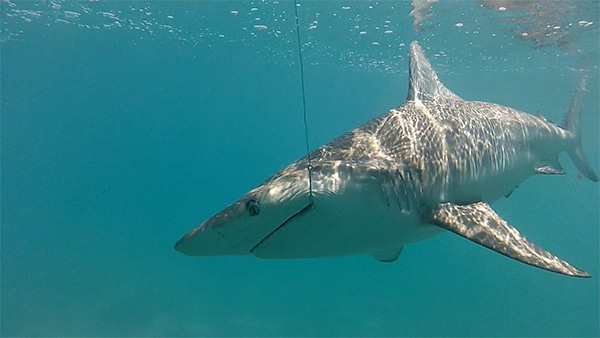
Heads-Up
Even now, landing a spinner can be the worst of nightmares. Or, for aficionados, the height of nirvana. During the first few seconds, your heart pumps wildly, while the shark heads for parts unknown, leaving a trail of froth and foam. Your captain needs to stay on the lookout for double reverses, and be ready to move to keep the shark from jumping into the boat.
I remember getting multiple hits on a single cast with a surface plug, and then having to stop reeling to avoid disaster when an unseen follower appeared, ready to launch himself at the plug on a trajectory that would have carried him into the boat. That one left me soaked from the splash.
Spinners roam the Atlantic and Gulf of Mexico, from North Carolina and the northern Gulf south to Brazil. Frequently confused with its cousin, the blacktip, both are reputed to travel together. Spinners are renowned for their spawning migration that begins in late fall, which drives countless numbers into South Florida waters, specifically to the 50-plus miles of Atlantic coastline between Fort Pierce and Boca Raton inlets.
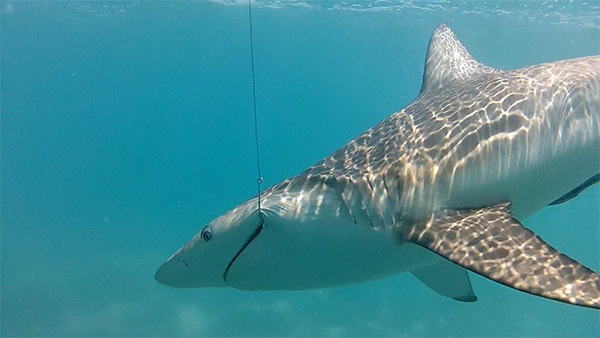
Welcome Winter
Typically they gather close to the beach, after arriving in force with the first major cold fronts of the winter. The best time to target these sharks is from December through April, when free-jumpers can be seen from the beach, and boating anglers easily spot them over the white-sand bottom. Every year the media descends on their arrival, with its breathless reporters and “eyes in the sky” newscasts, some of which even make it to national newscasts.
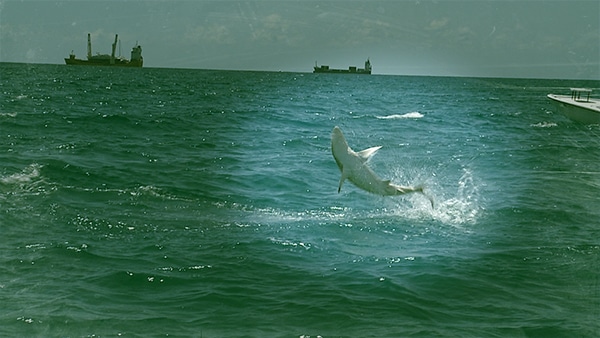
Local Knowledge
No one knows spinner sharks better than Capt. Greg Bogdan, who operates the 28-foot Conch Permitted out of Sailfish Marina in Palm Beach Shores, where his customers (kids included) consider spinners a big-ticket draw. When the spinners are in, Bogdan has no trouble finding them, by running the beach in 10 to 30 feet of water cautiously, as ground swells can form here with little warning. He locates clear water, usually south of Jupiter Inlet, and looks for either loose aggregations, with the sharks swimming a few yards apart, or free-jumping singles. They’re hard to miss. What’s behind the free-jumping is open to debate, but we know for sure that hooked spinners jump, a dozen or more times in a row. Think a mako is tough? Try hooking a spinner, which keeps spiraling in the direction it was originally headed, while your line rips the surface like cardboard tearing.
Spinners respond to an assortment of live and dead baits, as well as lures and flies. Of course, nothing sweetens the pot like chum, which in South Florida includes Spanish mackerel and bluefish (both are usually abundant when the spinners are running), small jacks, blue runners and ladyfish. One way to have plenty on hand is to troll the shallows with small jigs and spoons.
Fine-Tuning
All, typically, are butterflied and hung from a cleat to dangle in the water and release scent, with a slab of fillet reserved for bait. Bogdan chums, whether he’s drifting or anchored, based on sea conditions. Bogdan refuses to anchor when the seas are rough: He knows it’s risky. If the wind’s in the west, he’ll let it push his boat offshore while he lays out a scent trail from the beach to prime spinner habitat in 60 feet of water. If the wind’s in the north or south with current running, he drops the hook, making sure he can quickly untie to allow an angler to pass beneath the anchor line while fighting a fish. Spinners like to circle the boat.
And he insists on fresh bait. “If a shark hits your bait and you miss him, replace the bait,” he says. “Something happens when they grab it — maybe they secrete a chemical — that makes it less attractive to the next one that sniffs it. I know it sounds crazy, but this can make a big difference with finicky feeders.”
There’s much more to spinners than superbraid. As Bogdan explains, they can sometimes be picky. “Some days they want baits only near the surface, so I’ll suspend the bait under a balloon — stick to blue ones. Red or orange is easier to track; they’re also the spinner’s favorite colors — that’s why most of my lures are painted accordingly — yet they virtually ignore blue,” he says. When a hooked spinner trails a deflated blue balloon, others in the area aren’t likely to grab it.
We keep learning new tricks, while they keep outsmarting us, like any great game fish.
I’ve become, along with others, an apostle for this trip-hammer species, and eagerly await their arrival.
Just shark fishing, you say? Give it a try and you’ll think otherwise!

